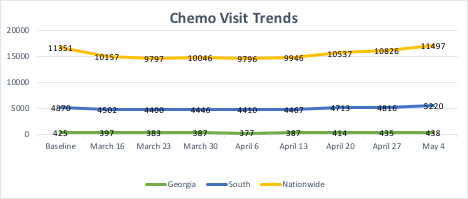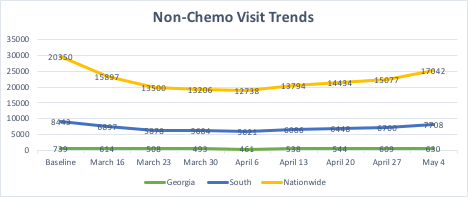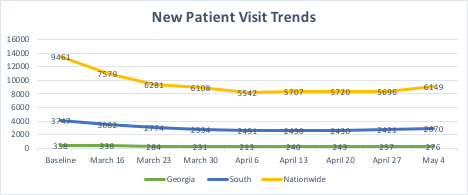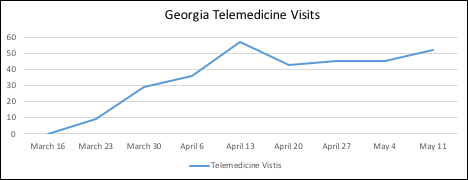Comparing Community Practice Data in Georgia with the South and U.S.
James Hamrick, MD, MPH, Senior Medical Director, Flatiron Health

An analysis of national Flatiron data from more than 270 community practices, seven of which are in Georgia, highlights trends in community cancer care in the seven weeks beginning March 16, 2020. While cancer patients and community practices are being severely impacted by COVID-19, practices are adapting rapidly and continue to deliver care in unprecedented circumstances. Notably, when CMS announced that telemedicine visits would be billable on parity with office visits, practices in Georgia immediately implemented telemedicine to enable access to care in the context of social distancing.
However, data reveal that total visits, new patient visits, and non-chemotherapy visits went down across the country, in the south, and in Georgia while chemotherapy visits went up marginally overall. Of note, chemotherapy visits dropped then rebounded, indicating that despite being essential, these services were also impacted by COVID-19.
These trends may be indicative of delays in diagnosis and care, as well as potentially worsening cancer outcomes for patients. In spite of their remarkable adaptation in the midst of a pandemic, oncology practices are being challenged by decreases in patient visits and delays in care which may impact their viability. It remains to be seen how and when patients who have experienced delays in diagnosis and access to care will re-enter the system, and which groups will be most impacted in terms of overall outcomes.
Baseline comparison data through May 4, 2020:
| Total Visits |
 |
US down 16%; South down 9%; Georgia down 13% |
| New Patient Visits |
 |
US down 35%; South down 29%; Georgia down 23% |
| Chemo Visits |
 |
US up 1%; South up 7%; Georgia up 3% |
| Non Chemo Visits |
 |
US down 16%; South down 9%; Georgia down 15% |




*The above data are sourced from over 270 community oncology practices that use Flatiron’s OncoEMR® platform. The data may not be fully representative of Flatiron’s research grade datasets and should only be considered directional. ©Flatiron Health 2020